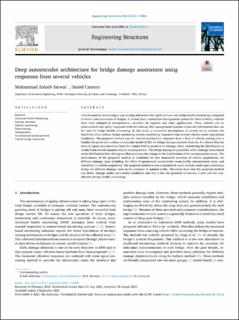| dc.contributor.author | Sarwar, Muhammad Zohaib | |
| dc.contributor.author | Cantero, Daniel | |
| dc.date.accessioned | 2021-09-20T06:19:16Z | |
| dc.date.available | 2021-09-20T06:19:16Z | |
| dc.date.created | 2021-09-04T14:20:17Z | |
| dc.date.issued | 2021 | |
| dc.identifier.citation | Engineering structures. 2021, 246, . | en_US |
| dc.identifier.issn | 0141-0296 | |
| dc.identifier.uri | https://hdl.handle.net/11250/2778983 | |
| dc.description.abstract | Vehicle-assisted monitoring is a promising alternative for rapid and low-cost bridge health monitoring compared to direct instrumentation of bridges. In recent years, centralized management systems for fleets of heavy vehicles have been adopted in transportation networks for logistics and other applications. These vehicles can be instrumented and easily integrated with the existing fleet management systems to provide information that can be used for bridge health monitoring. In this study, a numerical investigation is carried out to evaluate the feasibility of an indirect bridge monitoring system considering responses from several vehicles under operational conditions. The proposed method uses the vertical acceleration responses from a fleet of vehicles passing over a healthy bridge to train a deep autoencoder model (DAE) for bridge damage sensitive features. It is shown that the error in signal reconstruction from the trained DAE is sensitive to damage, when considering the distribution or results from several separate vehicle-crossing events. The bridge damage is quantified with a damage index based on the Kullback-Leibler divergence that evaluates the change in the distributions of the reconstruction errors. The performance of the proposed method is evaluated for two numerical scenarios of vehicle populations, for different damage cases including the effect of operational uncertainties (road profile, measurement noise, and variability in vehicle properties). The proposed method is also evaluated for more realistic multi-span continuous bridge for different damage cases in the presence of random traffic. The result show that the proposed method can detect damage under operational conditions and that it has the potential to become a new tool for cost-effective bridge health monitoring. | en_US |
| dc.language.iso | eng | en_US |
| dc.publisher | Elsevier Science | en_US |
| dc.rights | Navngivelse 4.0 Internasjonal | * |
| dc.rights.uri | http://creativecommons.org/licenses/by/4.0/deed.no | * |
| dc.title | Deep autoencoder architecture for bridge damage assessment using responses from several vehicles | en_US |
| dc.type | Peer reviewed | en_US |
| dc.type | Journal article | en_US |
| dc.description.version | publishedVersion | en_US |
| dc.source.volume | 246 | en_US |
| dc.source.journal | Engineering structures | en_US |
| dc.identifier.doi | https://doi.org/10.1016/j.engstruct.2021.113064 | |
| dc.identifier.cristin | 1931352 | |
| dc.description.localcode | This is an open access article distributed under the terms of the Creative Commons CC-BY license, which permits unrestricted use, distribution, and reproduction in any medium, provided the original work is properly cited. | en_US |
| dc.source.articlenumber | 113064 | en_US |
| cristin.ispublished | true | |
| cristin.fulltext | original | |
| cristin.qualitycode | 2 | |

